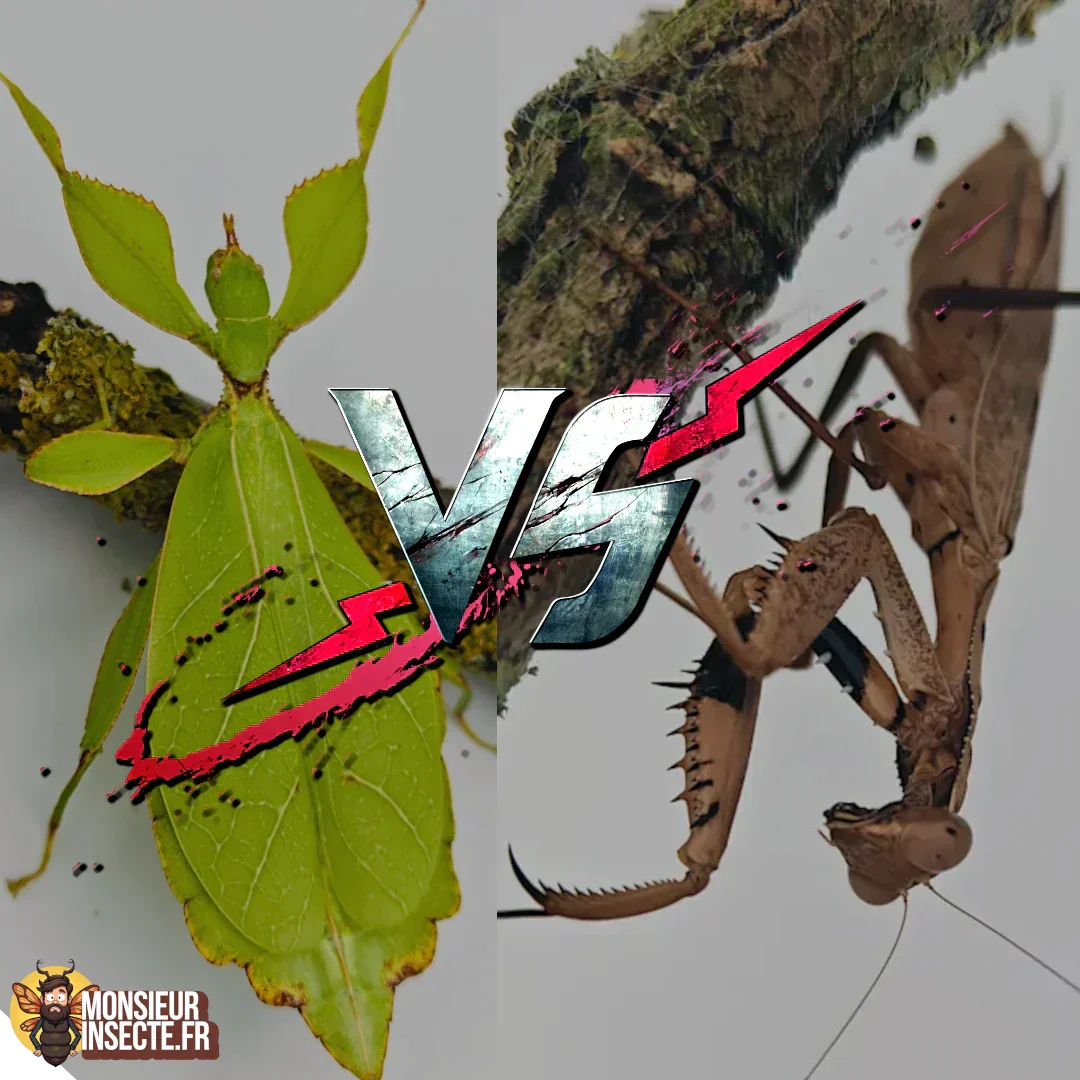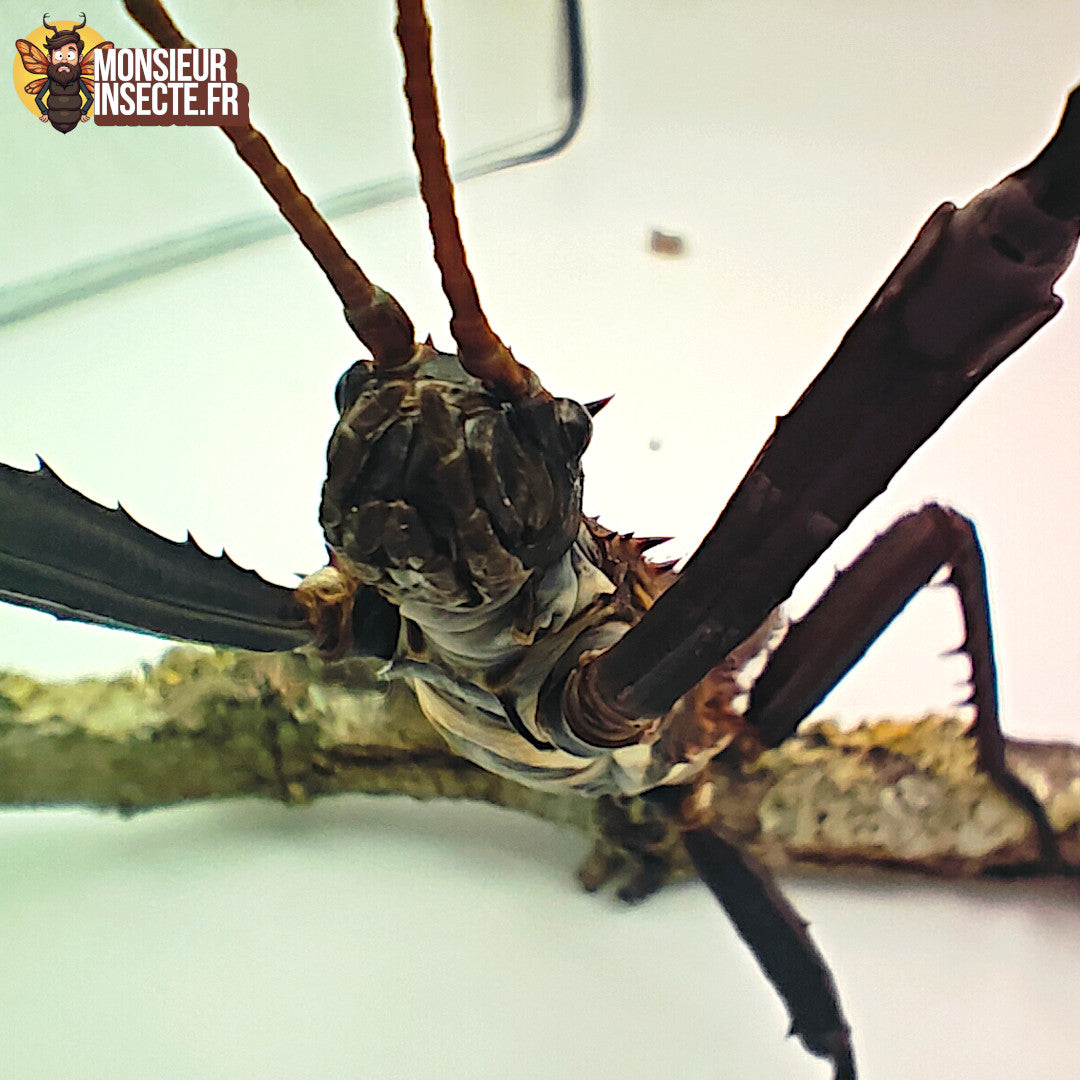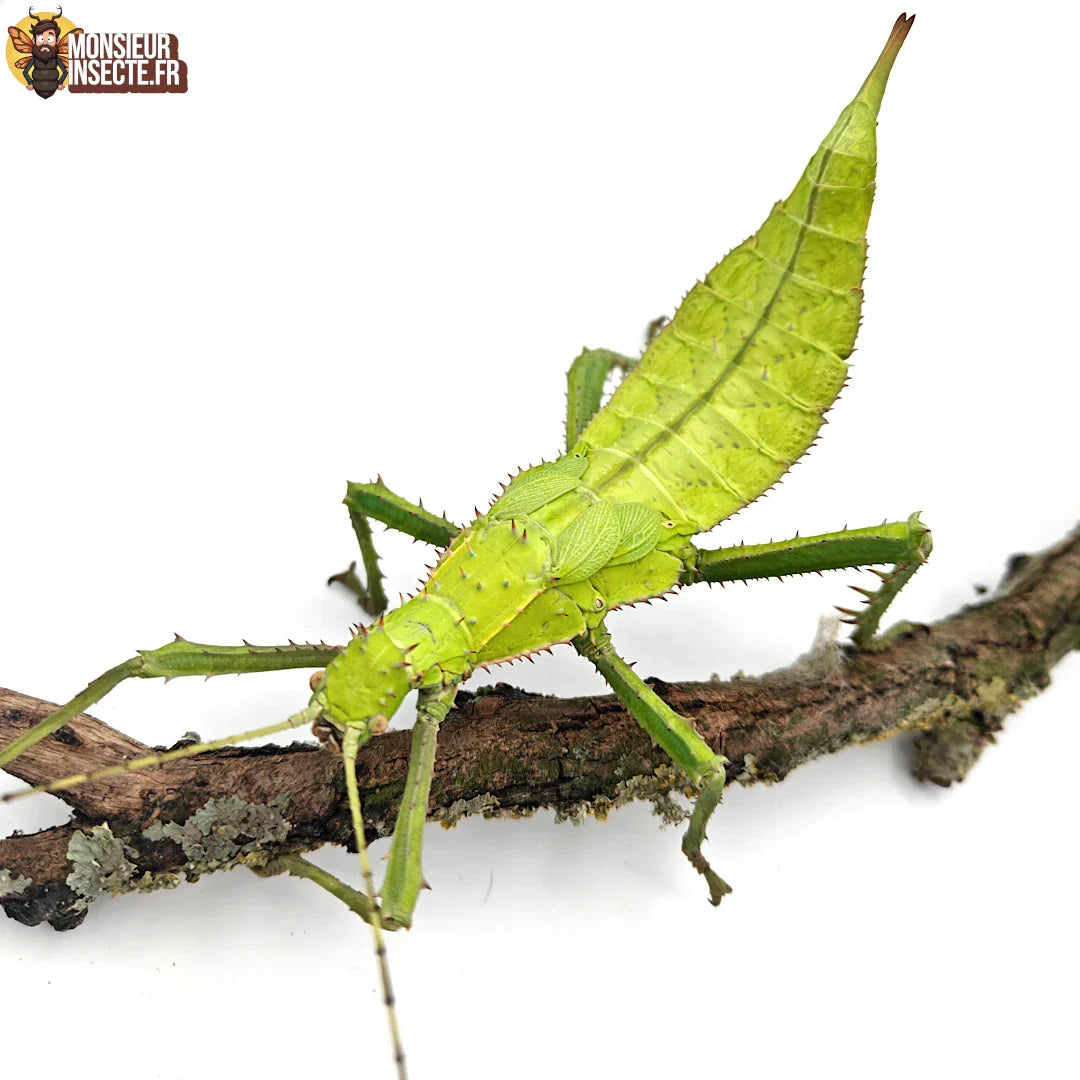Introduction
In the fascinating world of exotic insects, two creatures are of great interest: the praying mantis and the stick insect . These insects, both intriguing and aesthetically pleasing, are among the most popular pets among entomology enthusiasts and lovers of unusual animals. But then, praying mantis or stick insect ? Which insect will best suit your needs? Discover our detailed comparison to help you make the right choice.
What is a praying mantis?

My little protégé, the Prohierodula Picta. A fierce and aggressive mantis with a constant hunger that even makes it chase after its prey! (available here)
The praying mantis (or Mantodea, the title "praying mantis" actually only applies to a small part of the kingdom ), with its large front legs folded as if in prayer, is one of nature's most iconic insects. Its unique behavior, its ability to capture its prey with remarkable precision, and its magnificent colors make it a fascinating insect. Native mainly to Asia, the praying mantis is now widespread throughout the world, including in France.
Main characteristics of the praying mantis :
- Size: Between 4 and 12 cm, depending on the species
- Lifespan: 6 months to 2 years
- Behavior: Carnivorous, it feeds mainly on other insects.
What is a stick insect?

Necroscia Anullipes, a terrible stick insect to raise, especially if you have a lot of them. It loves to drop to the ground and hates being handled by humans. (available here for the bravest)
The stick insect , sometimes called a "stick insect," is an insect that has evolved to resemble a branch or leaf, providing natural protection from predators. There are many species of stick insects, each with distinct characteristics. Unlike the praying mantis, the stick insect is primarily herbivorous and is known for its patience and calmness.
Main characteristics of the stick insect :
- Size: Varies from 5 to 30 cm, depending on the species. Yes THIRTY CM.
- Shelf life: Up to 1 year
- Behavior: Herbivore, it feeds on plant leaves.
So? Praying mantis or stick insect: Which insect should you choose?
1. Ease of maintenance
- Praying Mantis : Praying mantis are generally very clean; there's no need to clean their terrarium every week. Once a month is fine.
- Stick insects : Stick insects are significantly "dirtier." Because of their herbivorous diet, they eat a lot. And so they "evacuate" a lot. Therefore, they clean more regularly.
Final Thoughts: Praying mantises are easier to keep and often require less space. Praying mantis egg cases are also very easy to locate, while stick insect eggs can be well hidden. See the sungaya inexpectata burying its eggs.

The sungaya inexpectata stick insect above buries its eggs. Quite a job for the breeder ;) available here
2. Character and interaction
- Praying Mantis : The mantis offers a wide variety of behavior, from shy to hunting, including flying or not, there is plenty to observe.
- Stick Insect : Stick insects are much more passive and less interactive. They spend most of their time camouflaged and feeding quietly.
Final opinion: Mantises are "better" when it comes to hunting and interacting with humans. I invite you to watch the video on this page . I show a mantis that has become accustomed to my presence because of my handling. When I enter my breeding greenhouse, she always comes to the door of her terrarium hoping that I will walk her. And yet she is a female, her behavior should be static.
However, mantises can be somewhat aggressive, especially the African species and females during the breeding season. Nothing really dangerous for humans, at most a needle prick on the tip of a finger, but it's worth mentioning. And you really have to want to.
For their part, stick insects present very little risk but appreciate human handling less. I find them to be more "impersonal" insects than mantises. Note that this appreciation is entirely relative, as insects are not capable of "love and affection." Let's say that their affection will be more of an acceptance of handling.

This kind of stick insect can still pierce your fingers if you look for it 😁
3. Aesthetics and appearance
- Praying Mantis : With its upright front legs and piercing gaze, the praying mantis has a unique and fascinating appearance. It is ideal for lovers of insects and spectacular behavior.
- Stick Insect : The stick insect, thanks to its impressive camouflage, is a fascinating insect to observe for its ability to blend into its environment. It is the perfect insect for those looking for a discreet and striking-looking animal.
Final Opinion: Tie. Stick insects exhibit more incredible variation from one species to another. A mantis, well... well, it's a mantis! It can come in all sorts of colors, patterns, and sizes and shapes, but it will never be as different as an Acryoptera maga stick insect can be from a Eurycantha Horrida stick insect.

Compare the mastiff in the previous photo with this small stick insect. A good example of the incredible diversity of stick insects.
However, it cannot be denied that the praying mantis, with its hunting and somewhat "gloomy/frightening" appearance, also has a great charm.
Final opinion: Equal. From a strictly biological point of view, the stick insect is perhaps a little richer. From a romantic point of view, the praying mantis has a terrible aura.
4. Food
- Praying Mantis : Less work but more complicated, and you'll have to handle cockroaches and flies and not overfeed. So not for everyone.
- Stick insect : More work and will require going once every 7-10 days to pick your favorite plant. For the majority of species, bramble and privet are enough (and can be found everywhere in France) but for some, get ready! They will need guava or St. John's wort, for example, which are already much harder to find. And when you change the food, you will have the pleasure of flushing out your stick insects one by one to transfer them to the new plant. One or two is fine, but around thirty is already more of a challenge. Advantage for the stick insect: it is not possible to overfeed, the stick insect regulates itself.
Final opinion: The EVERYDAY mantis. But only once you have understood how often to feed it (if you are lost , check out this tutorial) . Stick insects require going outside and refreshing their host plants often. Whereas a mantis's diet is limited to 2/3 cockroaches per week.
5. Reproduction
- Praying Mantis : You already know the answer 😂. Yes, it's a pain, and that's what explains the average price difference between a stick insect and a mantis (€5 versus €15 for a common species). Honestly, if you've never done it before, you'll probably miss out on your first breeding.
-
Stick Insect : It couldn't be simpler, and it frequently reproduces within itself (parthenogenesis). Lays eggs and, 6-10 months later, you'll have the little zerglings.
Final opinion: Undeniable advantage to stick insects. Highly prolific, frequent parthenogenesis, easily identifiable eggs, no need for human interaction... It's simple: They have all the advantages.

Macro photo of a stick insect being born in one of my incubators. This little guy is ready to conquer the world!
Conclusion
Whether you choose the praying mantis or the stick insect , you're choosing a fascinating and unique insect. Each species has its own unique characteristics, and your choice will depend on your preferences for care, interaction, and appearance.
If you're looking for a calm and discreet companion, the stick insect will be perfect for you. The herbivorous side will also be more suited to some. However, it will require going out to gather its food. Reproduction is very simple.
On the other hand, if you are attracted by a dynamic and spectacular insect, the praying mantis will be an ideal choice but be careful you will need a small cockroach farm on the side. Its reproduction is complex and requires patience. It is also more aggressive than most stick insects (except the diabolical Heteropteryx dilatata 😂). Once again I must point out that this aggressiveness is really minimal and does not represent a danger to humans. No insect will ever harm you on its own. You really have to corner it and threaten it for it to try to defend itself, and even then its means of defense are quite derisory for a human.
Don't wait any longer to welcome an exotic insect into your life! Discover our selection of praying mantises and stick insects and begin your entomological adventure today.
Need advice? Find me on social media where I respond quickly (link at the bottom of the page).




2 comments
Richard
Bonjour
Je souhaiterais faire un élevage de phasmes bâton pour ma classe
Que me conseillez vous ?
Merci d’avance
Anais
Merci pour le tuto vais quand même prendre une mante et tant pis pour les cafards ☠😂
Leave a comment
This site is protected by hCaptcha and the hCaptcha Privacy Policy and Terms of Service apply.